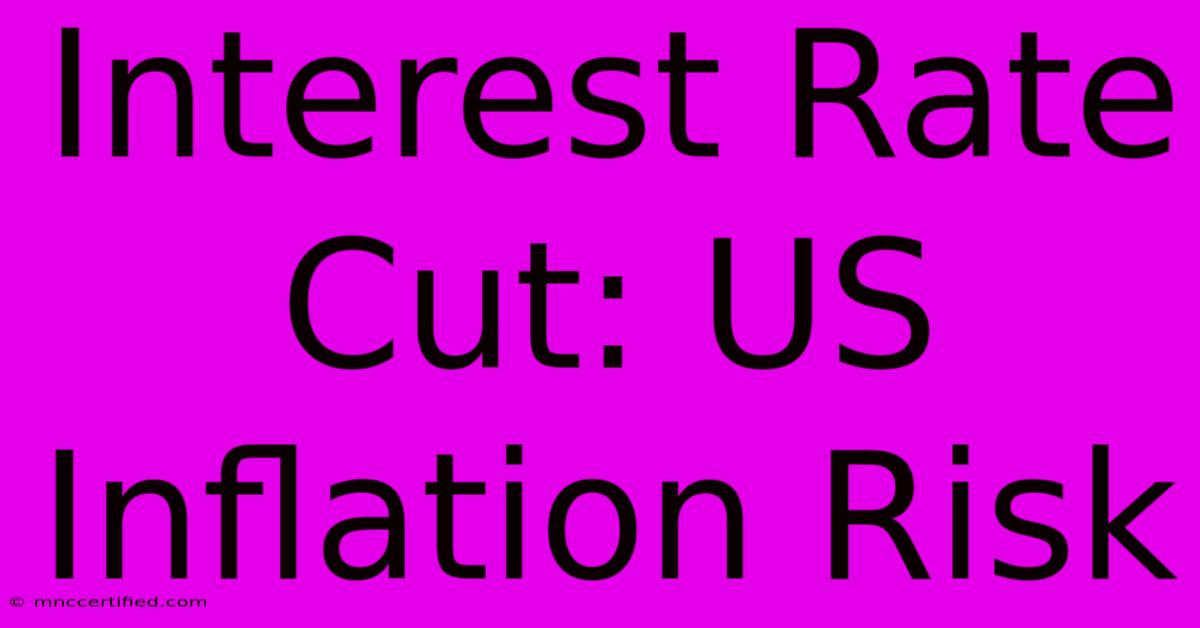Interest Rate Cut: US Inflation Risk

Table of Contents
Interest Rate Cut: Navigating the US Inflation Risk
The Federal Reserve's (Fed) decisions regarding interest rate cuts are always closely watched, impacting everything from mortgages to the stock market. Currently, the debate surrounding a potential interest rate cut is particularly intense, largely fueled by concerns about the US economy and the persistent, albeit cooling, inflation rate. This article will delve into the complexities of this situation, examining the potential benefits and significant risks associated with a rate cut in the context of ongoing inflation.
Understanding the Current Economic Landscape
The US economy is facing a challenging period. While inflation has begun to ease from its peak, it remains stubbornly above the Fed's 2% target. This persistent inflation, coupled with concerns about potential recession, creates a difficult dilemma for policymakers. High inflation erodes purchasing power and necessitates aggressive action, while simultaneously, the threat of a recession necessitates a more cautious approach to avoid further economic damage.
The Inflationary Pressure Cooker
Several factors continue to fuel inflationary pressures:
- Supply Chain Disruptions: While easing, lingering supply chain issues continue to impact prices.
- Energy Prices: Volatility in global energy markets significantly contributes to inflation.
- Wage Growth: Strong wage growth, while positive for workers, can contribute to inflationary pressures if not carefully managed.
- Geopolitical Instability: Global conflicts and uncertainties contribute to overall economic instability and price increases.
The Case for an Interest Rate Cut
Advocates for an interest rate cut argue that it's necessary to stimulate economic growth and prevent a recession. Lower interest rates can:
- Boost borrowing: Making it cheaper for businesses to invest and expand, potentially creating jobs and stimulating economic activity.
- Increase consumer spending: Lower borrowing costs can encourage consumers to spend more, further boosting the economy.
- Support the housing market: Reduced mortgage rates can help revive a potentially slowing housing sector.
The Risks of an Interest Rate Cut During Inflation
However, cutting interest rates while inflation remains elevated carries substantial risks:
- Exacerbated Inflation: Lowering rates could reignite inflationary pressures by increasing demand without a corresponding increase in supply. This could lead to a wage-price spiral, where rising prices lead to higher wages, further fueling inflation.
- Weakened Dollar: Reduced interest rates might weaken the US dollar, making imports more expensive and further contributing to inflation.
- Market Volatility: Uncertainty surrounding the Fed's decision can create volatility in the financial markets, potentially leading to instability.
- Delayed Inflation Control: A premature rate cut could delay the return of inflation to the Fed's target, prolonging the period of economic uncertainty.
The Fed's Tightrope Walk: A Delicate Balancing Act
The Fed is navigating a complex tightrope walk. They must balance the need to combat inflation with the risk of triggering a recession. Their decisions will depend on a careful assessment of several factors, including:
- Inflation data: The trajectory of inflation will be a key determinant in the Fed's decision-making process.
- Economic growth: Slowing economic growth might suggest a need for stimulus, while robust growth might allow for a more hawkish approach.
- Labor market conditions: The strength of the labor market will inform the Fed's assessment of inflationary pressures.
Conclusion: Uncertainty Reigns Supreme
The question of whether the Fed will cut interest rates remains unanswered. The decision will hinge on a complex interplay of economic indicators and the Fed's assessment of the risks and rewards. While a rate cut could provide short-term economic benefits, the potential to exacerbate inflation and prolong the current economic uncertainty is a significant concern. The coming months will be crucial in determining the Fed's course of action and its implications for the US economy. Closely monitoring economic data and the Fed's pronouncements is vital for individuals and businesses alike.

Thank you for visiting our website wich cover about Interest Rate Cut: US Inflation Risk. We hope the information provided has been useful to you. Feel free to contact us if you have any questions or need further assistance. See you next time and dont miss to bookmark.
Featured Posts
-
Cal Anderson Memorial Washington Location Set
Dec 19, 2024
-
Verstappen On Perezs Red Bull Exit
Dec 19, 2024
-
How To Stream Southampton Vs Liverpool
Dec 19, 2024
-
Farage In Talks With Musk On Donation
Dec 19, 2024
-
Real Madrid Defeats Pachuca
Dec 19, 2024